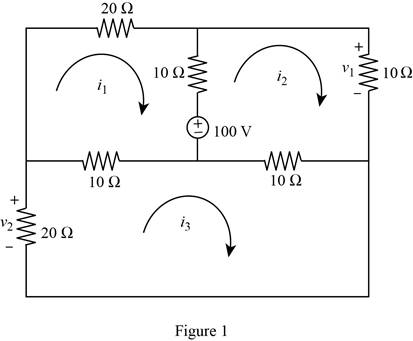
Concept explainers
Determine v1 and v2 in the circuit of Fig. 3.101.

Figure 3.101
For Prob. 3.56.
Find the voltages
Answer to Problem 56P
The value of voltages
Explanation of Solution
Given data:
Refer Figure 3.101 in the textbook for mesh analysis.
Calculation:
Redraw the given circuit as shown in Figure 1 with the mesh currents.

Apply Kirchhoff’s voltage law to loop 1 with current
Apply Kirchhoff’s voltage law to loop 2 with current
Apply Kirchhoff’s voltage law to loop 3 with current
Represent the equations (1), (2), and (3) in matrix form.
Obtain the value of the determinants as follows.
Write the expression for the mesh currents using Cramer’s rule.
Substitute
Substitute
With reference to Figure 1, write the expression for the voltages
Substitute
Substitute
Conclusion:
Therefore, the values of voltage
Want to see more full solutions like this?
Chapter 3 Solutions
Fundamentals of Electric Circuits
- 3z²+7z+1 dz (b) If C is the circle |z+i|=1. What is the value of S (a) If C is the circle |z+1|=1. z+1 (c) If C is the ellipse x²+y2=8.arrow_forward= Find the residues of all the poles of f(z) = 3z (z+2)²(z²-1)arrow_forward1 ezt Evaluate Sc z² (z²+2z+2) 2πί |z|=3 and t=constant. dz using residue theorem if C is the circlearrow_forward
- Find Z-1 {(z-1)²(2-2)(2-3)) 2z using residue theorem.arrow_forwardPlease answer allarrow_forwardfind the inverse Laplace transform of X(s)= i) Re[s]> 3 ii) Re[s]<1 s+5 for (s-1)(s-2)(s-3) iii) 1arrow_forwardFor R1, what is the resistance in kΩ? For R1, what the current in mA? For R1, what is the voltage in V? For R1, what is the power in W? For R2, what is the resistance in kΩ? For R2, what the current in mA? For R2, what is the voltage in V? For R2, what is the power in W? For R3, what is the resistance in kΩ? For R3, what the current in mA? For R3, what is the voltage in V? For R3, what is the power in W? For R4, what is the resistance in kΩ? For R4, what the current in mA? For R4, what is the voltage in V? For R4, what is the power in W? For R5, what is the resistance in kΩ? For R5, what the current in mA? For R5, what is the voltage in V? For R5, what is the power in W? What is the total resistance in Ω? What is the total current in mA? What is the total voltage in V? What is the total power in W?arrow_forwardPlease answer allarrow_forward£1² = 2+ cos(5+) u(4-1) 7- =£ (t-1+1) 2 J -2(+-1+1) Cas [5(4-1+1)] uct-1) e S es { ((+1) = 2(4+1) cos [5 (+1)] u(+)arrow_forwardarrow_back_iosSEE MORE QUESTIONSarrow_forward_ios
 Introductory Circuit Analysis (13th Edition)Electrical EngineeringISBN:9780133923605Author:Robert L. BoylestadPublisher:PEARSON
Introductory Circuit Analysis (13th Edition)Electrical EngineeringISBN:9780133923605Author:Robert L. BoylestadPublisher:PEARSON Delmar's Standard Textbook Of ElectricityElectrical EngineeringISBN:9781337900348Author:Stephen L. HermanPublisher:Cengage Learning
Delmar's Standard Textbook Of ElectricityElectrical EngineeringISBN:9781337900348Author:Stephen L. HermanPublisher:Cengage Learning Programmable Logic ControllersElectrical EngineeringISBN:9780073373843Author:Frank D. PetruzellaPublisher:McGraw-Hill Education
Programmable Logic ControllersElectrical EngineeringISBN:9780073373843Author:Frank D. PetruzellaPublisher:McGraw-Hill Education Fundamentals of Electric CircuitsElectrical EngineeringISBN:9780078028229Author:Charles K Alexander, Matthew SadikuPublisher:McGraw-Hill Education
Fundamentals of Electric CircuitsElectrical EngineeringISBN:9780078028229Author:Charles K Alexander, Matthew SadikuPublisher:McGraw-Hill Education Electric Circuits. (11th Edition)Electrical EngineeringISBN:9780134746968Author:James W. Nilsson, Susan RiedelPublisher:PEARSON
Electric Circuits. (11th Edition)Electrical EngineeringISBN:9780134746968Author:James W. Nilsson, Susan RiedelPublisher:PEARSON Engineering ElectromagneticsElectrical EngineeringISBN:9780078028151Author:Hayt, William H. (william Hart), Jr, BUCK, John A.Publisher:Mcgraw-hill Education,
Engineering ElectromagneticsElectrical EngineeringISBN:9780078028151Author:Hayt, William H. (william Hart), Jr, BUCK, John A.Publisher:Mcgraw-hill Education,





